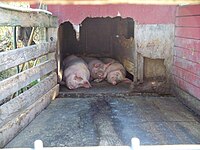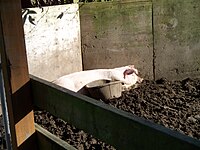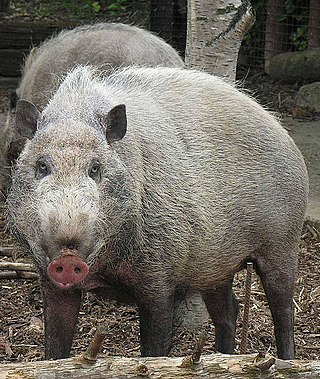
Sus is the genus of wild and domestic pigs, within the even-toed ungulate family Suidae. Sus include domestic pigs and their ancestor, the common Eurasian wild boar, along with other species. Sus species, like all suids, are native to the Eurasian and African continents, ranging from Europe to the Pacific islands. Suids other than the pig are the babirusa of Indonesia, the pygmy hog of South Asia, the warthogs of Africa, and other pig genera from Africa. The suids are a sister clade to peccaries.

Intensive pig farming, also known as pig factory farming, is the primary method of pig production, in which grower pigs are housed indoors in group-housing or straw-lined sheds, whilst pregnant sows are housed in gestation crates or pens and give birth in farrowing crates.

Animal husbandry is the branch of agriculture concerned with animals that are raised for meat, fibre, milk, or other products. It includes day-to-day care, selective breeding, and the raising of livestock. Husbandry has a long history, starting with the Neolithic Revolution when animals were first domesticated, from around 13,000 BC onwards, predating farming of the first crops. By the time of early civilisations such as ancient Egypt, cattle, sheep, goats, and pigs were being raised on farms.
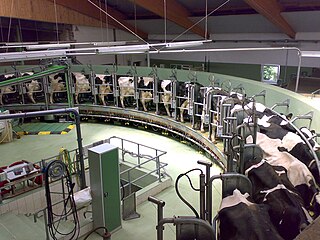
Dairy farming is a class of agriculture for the long-term production of milk, which is processed for the eventual sale of a dairy product. Dairy farming has a history that goes back to the early Neolithic era, around the seventh millennium BC, in many regions of Europe and Africa. Before the 20th century, milking was done by hand on small farms. Beginning in the early 20th century, milking was done in large scale dairy farms with innovations including rotary parlors, the milking pipeline, and automatic milking systems that were commercially developed in the early 1990s.
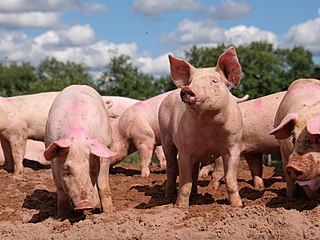
The pig, often called swine, hog, or domesticpig when distinguishing from other members of the genus Sus, is an omnivorous, domesticated, even-toed, hoofed mammal. It is variously considered a subspecies of Sus scrofa or a distinct species. The pig's head-plus-body length ranges from 0.9 to 1.8 m, and adult pigs typically weigh between 50 and 350 kg, with well-fed individuals even exceeding this range. The size and weight of hogs largely depends on their breed. Compared to other artiodactyls, a pig's head is relatively long and pointed. Most even-toed ungulates are herbivorous, but pigs are omnivores, like their wild relative. Pigs grunt and make snorting sounds.

The bushpig is a member of the pig family that inhabits forests, woodland, riverine vegetation and cultivated areas in East and Southern Africa. Probably introduced populations are also present in Madagascar. There have also been unverified reports of their presence on the Comoro island of Mayotte. Bushpigs are mainly nocturnal. There are several subspecies.

Heliciculture, commonly known as snail farming, is the process of raising edible land snails, primarily for human consumption or cosmetic use. The meat and snail eggs a.k.a. white caviar can be consumed as escargot and as a type of caviar, respectively.
Smithfield Foods, Inc., is a pork producer and food-processing company based in Smithfield, Virginia. It operates as an independent subsidiary of the Chinese-owned conglomerate WH Group. Founded in 1936 as the Smithfield Packing Company by Joseph W. Luter and his son, the company is the largest pig and pork producer in the world. In addition to owning over 500 farms in the US, Smithfield contracts with another 2,000 independent farms around the country to raise Smithfield's pigs. Outside the US, the company has facilities in Mexico, Poland, Romania, Germany, Slovakia and the United Kingdom. Globally the company employed 50,200 in 2016 and reported an annual revenue of $14 billion. Its 973,000-square-foot meat-processing plant in Tar Heel, North Carolina, was said in 2000 to be the world's largest, slaughtering 32,000 pigs a day.

Industrial agriculture is a form of modern farming that refers to the industrialized production of crops and animals and animal products like eggs or milk. The methods of industrial agriculture include innovation in agricultural machinery and farming methods, genetic technology, techniques for achieving economies of scale in production, the creation of new markets for consumption, the application of patent protection to genetic information, and global trade. These methods are widespread in developed nations and increasingly prevalent worldwide. Most of the meat, dairy, eggs, fruits and vegetables available in supermarkets are produced in this way.

Intensive animal farming, industrial livestock production, and macro-farms, also known as factory farming, is a type of intensive agriculture, specifically an approach to animal husbandry designed to maximize production while minimizing costs. To achieve this, agribusinesses keep livestock such as cattle, poultry, and fish at high stocking densities, at large scale, and using modern machinery, biotechnology, and global trade. The main products of this industry are meat, milk and eggs for human consumption. There are issues regarding whether intensive animal farming is sustainable in the social long-run given its costs in resources. Analysts also raise issues about its ethics.
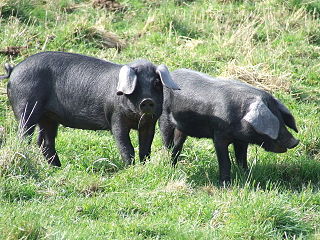
The Large Black pig is a British breed of domestic pig. It is the only British pig that is entirely black. It was created in the last years of the nineteenth century by merging the black pig populations of Devon and Cornwall in the south-west with those of Essex, Suffolk and Kent in the south-east. It is hardy, docile and prolific; it forages well and is suitable for extensive farming, but not well suited to intensive management.

Animal feed is food given to domestic animals, especially livestock, in the course of animal husbandry. There are two basic types: fodder and forage. Used alone, the word feed more often refers to fodder. Animal feed is an important input to animal agriculture, and is frequently the main cost of the raising or keeping of animals. Farms typically try to reduce cost for this food, by growing their own, grazing animals, or supplementing expensive feeds with substitutes, such as food waste like spent grain from beer brewing.

A pig toilet is a simple type of dry toilet consisting of an outhouse mounted over a pigsty, with a chute or hole connecting the two. The pigs consume the feces of the users of the toilet, as well as other food.

Pig farming or pork farming or hog farming is the raising and breeding of domestic pigs as livestock, and is a branch of animal husbandry. Pigs are farmed principally for food and skins.

The Ossabaw Island Hog or Ossabaw Island is a breed of pig derived from a population of feral pigs on Ossabaw Island, Georgia, United States. The original Ossabaw hogs are descended from swine released on the island in the 16th century by Spanish explorers. A breeding population has been established on American farms off the island, but they remain a critically endangered variety of pig.
Precision livestock farming (PLF) is a set of electronic tools and methods used for the management of livestock. PLF involves automated monitoring of animals to improve their production/reproduction, health, welfare, and impact on the environment. PLF tracks large animals, such as cows, "per animal"; however, it tracks smaller animals, such as poultry, "per flock", wherein the whole flock in a house is treated as one animal. Tracking "per flock" is widely used in broilers.
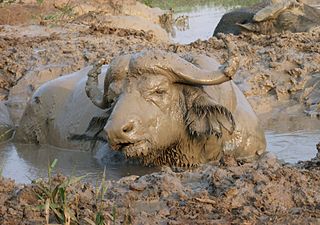
Wallowing in animals is comfort behaviour during which an animal rolls about or lies in mud, water or snow. Some definitions include rolling about in dust, however, in ethology this is usually referred to as dust bathing. Wallowing is often combined with other behaviours to fulfil its purpose; for example, elephants will often blow dirt over themselves after wallowing to create a thicker "coating", or pigs will allow the mud to dry before rubbing themselves on a tree or rock to remove ectoparasites stuck in the mud.
Risk assessment for organic swine health is the process of evaluating the likelihood and potential impact of various factors that may affect the health and well-being of organic swine. Risks associated with organic swine farming may differ to those associated with non-organic swine farming, and is of increasing relevance due to growth in the sector. While organic swine farming makes up a small share of U.S. swine farming overall, numbers have increased significantly in recent years. Additionally, non-certified organic swine herds are not accounted in official statistics. Consumer demand, stemming from the larger organic agriculture movement has helped spur growth in this industry.
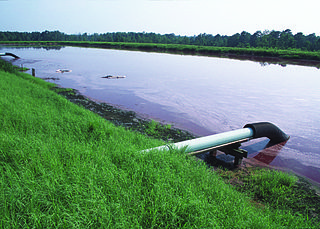
The environmental impact of pig farming is mainly driven by the spread of feces and waste to surrounding neighborhoods, polluting air and water with toxic waste particles. Waste from pig farms can carry pathogens, bacteria, and heavy metals that can be toxic when ingested. Pig waste also contributes to groundwater pollution in the forms of groundwater seepage and waste spray into neighboring areas with sprinklers. The contents in the spray and waste drift have been shown to cause mucosal irritation, respiratory ailment, increased stress, decreased quality of life, and higher blood pressure. This form of waste disposal is an attempt for factory farms to be cost efficient. The environmental degradation resulting from pig farming presents an environmental injustice problem, since the communities do not receive any benefit from the operations, and instead, suffer negative externalities, such as pollution and health problems. The United States Agriculture and Consumer Health Department has stated that the "main direct environmental impact of pig production is related to the manure produced.
This glossary of agriculture is a list of definitions of terms and concepts used in agriculture, its sub-disciplines, and related fields, including horticulture, animal husbandry, agribusiness, and agricultural policy. For other glossaries relevant to agricultural science, see Glossary of biology, Glossary of ecology, Glossary of environmental science, and Glossary of botanical terms.




